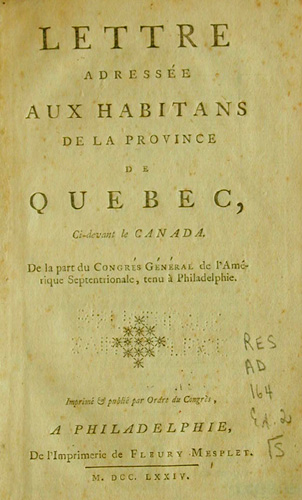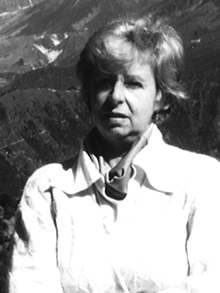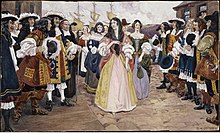
New France was the territory colonized by France in North America, beginning with the exploration of the Gulf of Saint Lawrence by Jacques Cartier in 1534 and ending with the cession of New France to Great Britain and Spain in 1763 under the Treaty of Paris.

Paul de Chomedey de Maisonneuve was a French military officer and the founder of Ville-Marie, now the city of Montreal.

Jean Talon, Count d'Orsainville was a French colonial administrator who served as the first Intendant of New France. Talon was appointed by King Louis XIV and his minister, Jean-Baptiste Colbert, to serve as the Intendant of Justice, Public Order and Finances in Canada, Acadia and Newfoundland for two terms: 1665 to 1668 and 1670 to 1672.

Jeanne Mance was a French nurse and settler of New France. She arrived in New France two years after the Ursuline nuns came to Quebec. Among the founders of Montreal in 1642, she established its first hospital, the Hôtel-Dieu de Montréal, in 1645. She returned twice to France to seek financial support for the hospital. After providing most of the care directly for years, in 1657 she recruited three sisters of the Religieuses hospitalières de Saint-Joseph, and continued to direct operations of the hospital. During her era, she was also known as Jehanne Mance contemporarily by the French, and as Joan Mance by the English contemporarily.

The Letters to the inhabitants of Canada were three letters written by the First and Second Continental Congresses in 1774, 1775, and 1776 to communicate directly with the population of the Province of Quebec, formerly the French province of Canada, which had no representative system at the time. Their purpose was to draw the large French-speaking population to the American revolutionary cause. This goal ultimately failed, and Quebec, along with the other northern provinces of British America, remained loyal to Britain. The only significant assistance that was gained was the recruitment of two regiments totalling not more than 1,000 men.

The Quebec Citadelles were a Minor ice hockey team in the American Hockey League. They played in Quebec City, Quebec, Canada at the Colisée Pepsi. The name refers to the Citadelle of Quebec, a landmark fortification in that city since the late 17th century.

The colony of Canada was a French colony within the larger territory of New France. It was claimed by France in 1535 during the second voyage of Jacques Cartier, in the name of the French king, Francis I. The colony remained a French territory until 1763, when it became a British colony known as the Province of Quebec.

Micheline Lanctôt is a Canadian actress, film director, screenwriter, and musician.
Gaétan Soucy was a Canadian novelist and professor.

Louis Hébert is widely considered the first European apothecary in the region that would later become Canada, as well as the first European to farm in said region. He was born around 1575 at 129 de la rue Saint-Honoré in Paris to Nicolas Hébert and Jacqueline Pajot. He loved another woman but according to his father's wish he married Marie Rollet on 19 February 1601 at the Church of Saint-Sulpice, Paris.

Marguerite Bourgeoys, CND, was a French religious sister and founder of the Congregation of Notre Dame of Montreal in the colony of New France, now part of Québec, Canada.

Suzanne Chouinard Martel was a French Canadian journalist, novelist and children's writer.

The Congrégation de Notre Dame (CND) is a religious community for women founded in 1658 in Ville Marie (Montreal), in the colony of New France, now part of Canada. It was established by Marguerite Bourgeoys, who was recruited in France to create a religious community in Ville Marie. She developed a congregation for women that was not cloistered; the sisters were allowed to live and work outside the convent. The congregation held an important role in the development of New France, as it supported women and girls in the colony and offered roles for them outside the home.

The French term pure laine, refers to Québécois people of full French Canadian ancestry, meaning those descended from the original settlers of New France who arrived during the 17th and 18th centuries. Terms with a similar meaning include de souche and old stock as in "Old Stock Canadians".

The Maison Saint-Gabriel Museum is located in Montreal, Quebec and is dedicated to preserving the history, heritage and artifacts of the settlers of New France in the mid 17th century. The museum consists of a small farm, which has been administered for more than 300 years by the Sisters of the Congregation of Notre Dame of Montreal, founded by Marguerite Bourgeoys in Montreal in 1658.
Pierre Le Ber, a son of Jacques Le Ber and brother of Jeanne Le Ber, was a painter from Montreal.

The Société Notre-Dame de Montréal, otherwise known as the Société de Notre-Dame de Montréal pour la conversion des Sauvages de la Nouvelle-France, was a religious organisation responsible for founding Ville-Marie, the original name for the settlement that would later become Montreal. The original founders of the organization were Jérôme le Royer de la Dauversière, Jean-Jacques Olier and Pierre Chevrier. They were later joined by Paul de Chomedey, Sieur de Maisonneuve, and by Jeanne Mance. The organization's mission was to convert the Indigenous population to Christianity and found a Christian settlement, which would be known as Ville-Marie.
The Government of Trois-Rivières was one of three administrative divisions of the French colony of Canada from 1643 to 1764, the other two being the Government of Quebec and Government of Montreal. At the time of the New France, the colony was divided into five individual governments: one in Trois-Rivières, one in Quebec City, one in Montreal, one in Newfoundland and one in Acadia. Each of these regions was known as a government because it was headed by a governor. The Government of Trois-Rivières was the smallest of the three governments of the St. Lawrence Valley in both area and population.

The Troupes de la marine served in Canada during the period 1683–1715. The Marines were first sent to Canada in 1683 after an upsurge of Iroquois hostilities. The basic unit of the Marines in Canada was the company, with three or four officers, two sergeants, four corporals and lance-corporals, and a total complement of 33 to 52 officers and other ranks. The number of marines during the period peaked in 1688 with a total strength of 1,750 officers and other ranks. The other ranks were recruited in France, and were mostly volunteers, although Canada was not an attractive place to serve. Unskilled labourers dominated and almost a third of them came from the western parts of France. On the other hand, the officer corps was the subject of a gradual process of canadianization, with about a third of the officers serving in 1715 born in Canada.

Marguerite Bourgeoys Park is a park in the Pointe-Saint-Charles neighbourhood of the Le Sud-Ouest borough of Montreal, Quebec, Canada. It is bordered by du Parc Marguerite-Bourgeoys Street to the north and east, des Filles du Roy Street to the south, and Wellington Street to the west.


















